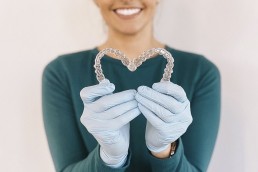Of the myriad of reasons our patients share as a need for orthodontic care, fixing an overbite or underbite are two of the most common reasons expressed. Many people choose to fix an overbite and underbite for purely aesthetic reasons. However, in some some extreme cases, they can cause serious health issues, such as speech impediments, trauma to the teeth, difficulty chewing, gum damage, jaw pain, and more.
Here’s how we use Invisalign to both correct overbites and underbites and help our patients sustain overall health.
The Condition and Cause of Overbites and Underbites
An overbite occurs when the upper teeth cover the lower teeth — also known as an “overjet.” It generally occurs as a result of genetics, bad oral habits, or overdevelopment of the bone that supports the teeth. Overbites can lead to gum irritation and issues caused by wearing on the lower teeth unnaturally. It can also cause painful jaw and joint problems.
Conversely, underbites occur when the lower teeth extend out beyond the upper teeth, often making the lower jaw more prominent. This alignment occurs by the overgrowth of the lower jaw, undergrowth of the upper jaw, or both in some cases. Underbites prevent normal functions of the mouth from happening, including front teeth and molars, which can lead to painful tooth wear, joint issues, and limited function.
6 Tips for the Best Invisalign Experience
How Invisalign Repositions Teeth
Invisalign is used for multiple orthodontic treatments, including fixing overbites and underbites.
Invisalign straightens your teeth without wires and brackets, using a series of clear, customized, removable appliances called aligners. It’s virtually undetectable, which means hardly anyone will know that you’re straightening your teeth, making it very popular among our patients.
The Invisalign System combines advanced 3-D computer graphics technology with 100-year-old science of orthodontics. Invisalign aligners are designed to move your teeth in small steps to the desired final position prescribed by your orthodontist. Each aligner is precisely calibrated and manufactured to fit your mouth at each stage of the treatment plan.
How We Use Invisalign to Fix an Overbite and Underbite
In order to treat an overbite or underbite with Invisalign, it’s necessary to visit an orthodontist so that we can take a digital scan of the teeth to create a virtual 3D model of your mouth.
After sending precise treatment instructions, Invisalign uses advanced computer technology to translate these instructions in a sequence of finely-calibrated aligners. Each aligner is worn for one to two weeks and only taken out to eat, brush and floss. As you replace each aligner with the next, your teeth and jaw begin to move gradually into the correct positions — week-by-week until your teeth are perfectly aligned.
Invisalign is an easy and effective way to fix an overbite and underbite. We strongly recommend starting treatment at an early age — ideally during jaw development — for the best results. Invisalign aligners fit into your mouth perfectly and are easy to remove. With Invisalign, you’ll have fewer appointments and you can eat whatever you wish, making your road to a brighter smiler easy and fun!
If you’re interested in learning more about Invisalign, don’t hesitate to reach out. We look forward to meeting you!
Ready to schedule a free consultation?
April 7, 2020
A diastema, or gap between teeth, is usually a natural part of a child’s development. For many children, the gap between their two front teeth closes with the…
March 4, 2020
We all love a good transformation story, and there’s nothing better than celebrating our patients’ incredible orthodontic treatment journeys. In this post,…
January 15, 2020
The alignment of your teeth can drastically impact your health and overall comfort. If you or your child are consistently experiencing jaw pain, frequent…


